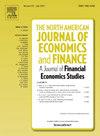重新审视黄金的对冲和避险作用:来自分位数方法的证据
IF 3.9
3区 经济学
Q1 BUSINESS, FINANCE
North American Journal of Economics and Finance
Pub Date : 2025-07-30
DOI:10.1016/j.najef.2025.102516
引用次数: 0
摘要
本文对2000年1月1日至2024年12月31日期间G7和E7国家股市中黄金作为避险工具、对冲工具和投资组合多元化工具的作用进行了全面的重新评估。我们采用了一个整合的经验框架,结合了分位数对分位数(QQ)回归、分位数内因果关系检验和交叉量化图方法。这种方法允许我们在黄金和股票收益的联合分布中捕捉不对称的和异构的依赖关系。调查结果显示,在大多数七国集团(G7)国家的市场低迷时期,黄金充当着避险工具的角色,尤其是在黄金在官方储备中占很大比例的国家。相比之下,在E7国家,黄金通常起到分散投资的作用。然而,在特定的不对称市场条件下,黄金在一些E7国家(如土耳其、印度和巴西)表现出对冲或避险行为。研究结果还强调了黄金储备构成在增强黄金避险属性方面的作用。在官方持有大量黄金的国家,黄金显示出更强大的避险能力。分位数因果关系分析进一步证实了分位数之间的双向和非线性预测关系,而递归和子样本QQ估计表明,黄金的避险功能是时变的,并随着系统性冲击而演变。这些发现强调了黄金作为风险管理工具在不同市场和经济条件下的不同有效性,强调了在不确定的金融环境中量身定制策略的重要性,为投资者和政策制定者提供了有价值的见解。本文章由计算机程序翻译,如有差异,请以英文原文为准。
Revisiting the hedging and safe haven roles of gold: Evidence from quantile-on-quantile approach
This paper provides a comprehensive reassessment of gold’s role as a safe haven, hedge, and portfolio diversifier across the stock markets of G7 and E7 countries from January 1, 2000, to December 31, 2024. We employ an integrated empirical framework, combining quantile-on-quantile (QQ) regression, causality-in-quantiles testing, and the cross-quantilogram method. This approach allows us to capture asymmetric and heterogeneous dependencies across the joint distribution of gold and stock returns. The findings reveal that gold acts as a safe haven during market downturns in most G7 countries, particularly where gold comprises a large share of official reserves. In contrast, gold typically serves as a diversifier in E7 countries. However, under specific asymmetric market conditions, gold exhibits hedging or safe-haven behavior in some E7 countries, such as Turkey, India, and Brazil. The results also highlight the role of gold reserve composition in enhancing gold’s safe-haven properties. In countries with substantial official gold holdings, gold demonstrates more robust safe-haven capabilities. The causality-in-quantiles analysis further confirms bidirectional and nonlinear predictive relationships across quantiles, while recursive and sub-sample QQ estimations indicate that the safe-haven function of gold is time-varying and evolves in response to systemic shocks. These findings provide valuable insights for both investors and policymakers by highlighting the varying effectiveness of gold as a risk management instrument across various markets and economic conditions, emphasizing the importance of tailored strategies in uncertain financial environments.
求助全文
通过发布文献求助,成功后即可免费获取论文全文。
去求助
来源期刊
CiteScore
7.30
自引率
8.30%
发文量
168
期刊介绍:
The focus of the North-American Journal of Economics and Finance is on the economics of integration of goods, services, financial markets, at both regional and global levels with the role of economic policy in that process playing an important role. Both theoretical and empirical papers are welcome. Empirical and policy-related papers that rely on data and the experiences of countries outside North America are also welcome. Papers should offer concrete lessons about the ongoing process of globalization, or policy implications about how governments, domestic or international institutions, can improve the coordination of their activities. Empirical analysis should be capable of replication. Authors of accepted papers will be encouraged to supply data and computer programs.

 求助内容:
求助内容: 应助结果提醒方式:
应助结果提醒方式:


